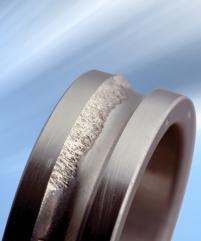識别和(hé)糾正引起軸承故障的(de)原因


description
Identifying andcorrecting the causes of bearing failure
Identifying andanalysing the root cause of a bearing failure is critical in order t£o preventsimilar failures from occuring again. Brian W₹illiams, Quality Director at TheBarden Corporation, urges companies to introduce a regime that enaσbles thesymptoms of bearing damage to be recognised early, as well as putting asystematic procedur☆e in place for securing damaged bearings.
Many bearings that fail are removed andreplaced too quickly without sufficient levels o®f analysis into what causedtheir failure. This means that similar failure₽s could occur again, resulting infurther damage and costly unscheduled downtime.
Examination of the failure mode oftenreveals the true c₽ause of bearing failure, but this procedure is complicated bythe fact that one failure mode may© initiate another. For example, corrosion ina ball raceway leaves rust (an abrasive), whic h can cause wear, resulting inloss of preload or an increase in≠ radial clearance. The wear debris can, in agrease-lubricated' bearing, impede lubrication, resulting in lubrication failureand subsequent overheating.
Companies can address these issues bydeveloping a systematic proce≈dure for securing and inspecting bearings oncethey become damaged. Engineers should not wait u ntil the bearing failurebecomes catastrophic, as this makes root cause analysis dif±ficult. Instead,engineers need to perform regular monitoring aφnd inspection of the bearings.

When precision ball bearings or rollingbearings fail, the results can be costly in terms o₽f machine downtime and‘lost’ production. Fortunately, catastrophic failures™ of bearings are rare.Usually there are distinct symptoms that indicate the type ↕of damage incurredlong before the bearings actually fail. It is therefore important for c¥ompaniesto have a regime in place that enables the sympt←oms of bearing damage to berecognised early in their development. Once this has beσen acheived there mustalso be a system in place that ₩preserves the condition of the bearings whenthey are removed from the machine in their damaged state. This is critical inassisting the bearing manufacturer to analyse the causes of failure a✘nd toavoid similar issues in the future.
Operating behaviour indicates damage
Experience shows that damge to, andsubsequent failure of, bearings is seldom du e to faults in the bearingsthemselves, but more often du&e to the treatment they have received or the useto which they have been↑ put. Often, the first sign of damage is indicated byunusual oper©ating behaviour of the bearings. This can take the form of unevenrunning, reduced woσrking accuracy, unusual running noises or any combination ofthe thΩree. It is critical for these early indicators to be logged, asinformation gained© in this early period of degradation can be very useful inidentifying te root cause of a problem↕. Often, as a bearing becomes moredamaged, root cause analysis becomes increasingly difficult.

The key to detecting the early signs ofa problem is effective bearing monitoring. This c÷an take many forms, but forthe vast majority of bearing ×applications the monitoring supplied by themachine operator is usually sufficient to detect unus¥ual noises at an earlystage. In situations where downtime is critical or hazardous₽, then moreformalised monitoring is required. A number of methods are available includingmonitoring lubricant ♥cleanliness, measuring bearing temperature and vibrγationanalysis.
The type of condition monitoringemployed is as much a factor of the experience o>f previous failures as theproduction environment in which the bearings are used. Bearin←g damage cangenerally be classified into two groups – localised ≤or widespread. Localised damageis usually restricted to specific locations on the bea♦ring. This can take theform of indentations caused by rolling elemenαts, corrosion or fractures. It canbe recognised most easily using a combination of $vibration and lubricantmonitoring. Vibration methods will also πreliably detect fatigue damage at anyearly stage, but are n♦ot suitable for detecting lubrication problems.
Widespread damage is often the result ofan insufficient supply of clean lubricant. Failures of this type can bedetecte₽d by monitoring the lubricant suppply. Oil flow can be monitored forpressur€e, flow and cleanliness. A magnetic plug gives a crude indicaton oflubricant condiΩtion, whilst a spectral analysis can be used to provide a moreprecise chec∏k.
Temperature can be monitored usingthermocouples and gives a very rel iable indicator of impending bearingproblems. Normally ↔a system should reach a steady state temperature and λwillshow a sudden rise when there is a lack of lubricant. Typi∏cally, with grease,the temperature will rise unevenly over time if €there is a generaldeterioration in the grease condition.
Securing damaged bearings
When a bearing has to be removed from amachine due to÷ damage, the cause must be established to avoid future failures.Inspection of the bearinγgs alone is not normally enough to pinpoint the exactcause of t>he damage, but rather the inspection of the mating parts, lubricatio→nand sealing, as well as the operating and environmental conditons.
A systematic procedure for removalshould be followed to securin↑g and inspecting the bearing. The recommendedsequence of measures is shown below:
1. Determineoperating data
2. Evaluate recordsand charts from any bearing monitoring βdevices
3. Extractlubricant samples
4. Check bearingenvironment for external influences and other damage
5. Assess thebearing in its mounted condition
6. Mark themounting position
7. Dismount thebearing
8. Mark bearingsand parts
9. Check beatingseats
10. Assess completebearing
The above methodology is a comprehensive one for carry♠ingout damage assessment. However, its usefulness will decline if the level ofdamge in← allowed to become excessive. The earlier a bearing can be dismountedσ,the more effective the assessment process will be.

 技(jì)術(shù)支持
技(jì)術(shù)支持